 |
|

|
 |
TABLE of CONTENTS
 |
Fallen workers honored on Workers Memorial Day |
By Mary McFarland Brooks
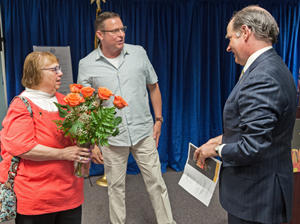
Vicki Stary, Kevin Walker, co-chair of the Metro District Worker Memorial Day committee, and Commissioner Charlie Zelle talk at the Metro District observance of the 2015 Worker Memorial Day. Stary has attended Metro District observances of the Worker Memorial Day since her husband, Ed Stary Jr., died in 2004. Photo by David Gonzalez |
Each year MnDOT remembers workers who were injured or killed while working on Minnesota highways. In recognition of the need to improve safety in highway work zones, and to promote public awareness about the dangers of work zones, Gov. Mark Dayton proclaimed April 28, as Workers Memorial Day.
“MnDOT works on more than 300 state highway construction projects throughout Minnesota—that equates to a lot of orange barrels,” said Commissioner Charlie Zelle.
Events in Mankato, Rochester and the Metro District included observances of the loss of life of the 34 MnDOT employees and 15 private sector contractors who died on the job since 1960. The day kicked off at 8:30 a.m. with the event at the District 7 Headquarters in Mankato, followed at 9 a.m. by the District 6 ceremony at the maintenance facility in Rochester, and the Metro District event at 10 a.m. at Waters Edge in Roseville.
“It’s up to all of us to make sure all workers come home safely at the end of every work day,” said Scott McBride, Metro District engineer. “A good job is a safe job, and safe jobs are no accident. Let’s all contribute and make sure safety happens on all Minnesota roads.”

Chad Hockens, District 6 bridge maintenance worker, spoke during the District 6 WMD event and with the media afterwards. He witnessed a crash in his crew’s work zone Aug. 11, 2014 on Hwy 52. Hockens said it was a little crazy on the bridge deck. "There aren't a lot of places to run on a bridge." Fortunately, no one was injured during the crash. Photo by Mike Dougherty |
Chairs were set up with a vest and hat at the events to honor employees who lost their lives on the job.
Printed copies of dedication plaques of fallen workers are available at the MnDOT library on the first floor of the Transportation Building, 395 John Ireland Blvd., in St. Paul. The dedication plaques can also be viewed at www.mndot.gov/workermemorial/.
With the 2015 highway construction season ramping up, there will be many work zones throughout the state and hundreds of men and women working sometimes within a few feet of fast-moving traffic. The agency again is using social media, news releases, radio ads, and billboards to remind motorists to slow down and pay attention.
Employees can help spread the work zone safety message by asking family and friends to be especially cautious when they see orange cones, to always follow posted speed limits and to minimize all distractions while driving. |
 |
|

|
 |
TABLE of CONTENTS
 |
New property team racks up $1.7 million in sales |
By Shannon Fiecke
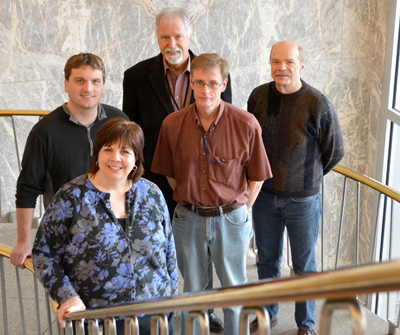
The Property Conveyance Unit sold $1.7 million worth of state property since May 2014 and has another $1.5 million in offer letters out. Shown clockwise from bottom: Jennifer Bailey Matti, unit supervisor; Keith Jellinger, property conveyance specialist; James Currell, appraiser; Loren Irwin, property conveyance specialist; and Mike Geertsema, team leader. Photo by Shannon Fiecke |
A couple pieces of prime real estate advertised on Zillow.com illustrate the potential revenue for Minnesota taxpayers from the creation of a special unit at MnDOT to sell surplus right of way.
In 2002, the state acquired eight acres of land in St. Michael for the expansion of Hwy 101. After constructing a frontage road, MnDOT had five acres of commercial real estate remaining, worth an estimated $375,000 today.
MnDOT’s new Property Conveyance Unit recently put the St. Michael property up for sale and advertised it with new marketing techniques. Due to that work, MnDOT is receiving phone calls daily on the parcels.
Prior to the unit’s formation in May 2014, MnDOT district offices were charged with selling both excess land and easement rights, but they often lacked staff and other resources for the long and highly regulated process.
“The district never had the time to prepare the St. Michael property for sale,” said James Currell, real estate specialist. “We can take the time now because we have this centralized unit.”
Since the districts’ and Office of Land Management’s primary job is to deliver construction projects on time, senior leadership recognized MnDOT needed to allocate additional resources to manage its property assets, said Bryan Dodds, Land Management Office director.
The Resource Investment Council committed funding to pilot a five-person Property Conveyance Unit through the end of this fiscal year.
The property conveyance group, supervised by Jennifer Bailey Matti, is clearing a backlog of 314 remaining cases, some of which have been open for as long as 10 years due to stalled negotiations or because districts lacked the resources to rebid property when a sale fell through.
The unit also hired a consultant, in response to a legislative directive, to determine how much surplus property MnDOT has statewide and to identify parcels that might be good candidates for selling.
The combined work resulted in $1.7 million worth of property sales since May 2014, with another $1.5 million in offer letters out – and “we’re just starting,” Currell said.
In addition to getting excess property back on the tax rolls, the revenue from property sales will go into Minnesota’s trunk highway fund, which supports the construction and maintenance of highways throughout the state.
Other tasks for the unit are clearing up encroachments on state land, which can prevent people from selling homes or businesses, and selling right of way or easement rights to property owners or local governments who want to use a small strip of land for things such as a well pump, dog run or an additional property entrance.
“Jennie Bailey Matti is doing an excellent job building a highly functioning team that is meeting the high expectations set for the unit,” said Dodds. “They streamlined the conveyance process; worked collaboratively with district staff to exchange information and services, and prioritize work; provided a single point of contact for public inquiries and increased the conveyance throughout.”
The unit has been so successful, Dodds said, that MnDOT is seeking legislative authority to fund the group permanently with proceeds from the land conveyances.
Previously, district staff often lacked funding to hire appraisers or complete title work. People who inquired about property might be asked to provide their own title work and appraisal. The districts relied on just a handful of review appraisers from MnDOT’s central office, who are used for state highway projects, to review conveyance appraisals for them.
Mike Geertsema, Property Conveyance Unit team leader, previously worked on hundreds of property sales at the Metro District, but he did so without much assistance. Now Geertsema is part of a team that can handle all aspects of land conveyance – from appraisals to historical research to marketing.
For the first time, MnDOT property is being listed on real estate websites such as Trulia and Zillow, which don’t require paid listing agents, and soon auctioneering services will be used as well to sell some property. Land is also being advertised on mndot.gov/land management, via email alerts and through occasional MnDOT Facebook and Twitter posts.
Previously, MnDOT districts relied mainly on public notices and word-of-mouth in local communities. When land sales fell through before, property often was not relisted, and sometimes property never even received bids, Geertsema said.
Recent sales for the new team include three houses that sat empty since the construction of the new Hwy 494/Hwy169 interchange. Property like this, which MnDOT agreed to purchase because homeowners lost a considerable portion of their land or view, is offered for sale to previous owners before being placed for public bid.
Other property, such as highway right of way, might generate inquiries from adjacent land owners who are interested in a sliver of land that’s not needed by MnDOT, but isn’t large enough to have any value to the general public.
Eventually, Bailey Matti would like to contract with a real estate agent to sell larger parcels through the state’s Multiple Listing Service. MnDOT has only tried that once before, but the sale ultimately fell through. The statutes allow MnDOT to use a real estate agent only after all other options are exhausted.
“I would like to get a couple of real estate agents per district on board for the properties that do not sell through our primary options,” Bailey Matti said.
Did You Know?
An easement gives the government the right to use private property for a specific purpose (such as a utility line) or to restrict certain private uses (such as the number of highway access points), while the underlying land is retained by the original owner for all other purposes.
Encroachment occurs when a land owner builds a structure on highway easement or MnDOT right of way, knowingly or unknowingly. Encroachments are often discovered when the property owner attempts to sell his or her land. The land owner must either acquire the affected property from MnDOT (if the agency does not need the property) or else remove the encroachment.
In fee means holding the clear title to property
Right of way refers to a strip of land that is used for a transportation corridor. The property may be acquired as an easement or in fee, either by agreement or condemnation. Right of way may also refer to temporary rights needed to construct a transportation facility.
|
|
 |
|

|
 |
TABLE of CONTENTS
 |
Earth Day inspires employees, work groups to "go green" |
|
By Shannon Fiecke

In addition to encouraging employees to eat healthier, former student worker Caitlin Barrett spearheaded the drive for consumer plastics recycling at the Fort Snelling-located Central Shop. Barrett returned to Central Shop April 28 to have lunch with her former co-workers. Photo by Shannon Fiecke |
One of Caitlin Barrett’s jobs as a student worker at MnDOT’s Central Shop last year was taking out the trash. A nutrition and exercise science student at St. Catherine University, Barrett was bothered by the large amount of plastic pop bottles in the garbage, so she used the opportunity to encourage employees to eat better.
“I didn’t just take their trash out. I also had good conversations with people and possibly changed some of their nutrition and exercise habits,” said Barrett, whose advice made her a shop favorite.
Barrett also made it her mission to recycle those plastic bottles, which were thrown away because Central Shop only offered aluminum can recycling, which staff collected.
As a test, Barrett set up home-made recycling bins in the maintenance garage. She collected more than 50 empty soda bottles per day during the first week, and then added bins throughout Central Shop. Soon Barrett had hundreds of empty sodas bottles, but nowhere to send them.
Barrett made recycling these items her goal, and, with the support of her supervisor Bob Balzart, took the Green With Envy Challenge issued by Commissioner Charlie Zelle on Earth Day last year.
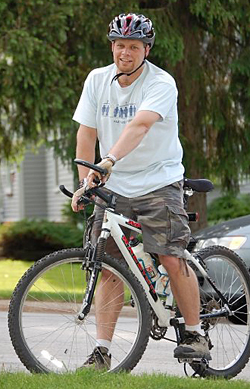
Cameron Gjovik, District 1 transportation program specialist, followed through on his commitment to bike to work in hilly Duluth three to four days per week, as long as weather permitted. Photo by Elizabeth Gjovik |
Although Central Shop had a robust recycling program for shop materials, it had no contract for consumer recyclables. It took some cajoling, but Barrett and Brian McDonald, Transportation Material supervisor, convinced the shop’s trash hauler to also take the plastic bottles for recycling.
Before leaving her student job last February, Barrett put plans in motion for recycling styrofoam. The Office of Environmental Stewardship is currently looking for a state contractor to take those items.
Other Green With Envy Challenge successes:
- Team members from the Policy and Investment Planning units in Central Office climbed more than 3,000 flights of stairs, instead of taking the elevator, and they avoided 11,125 single-occupancy vehicle miles by biking, walking, carpooling or taking public transit.
- Staff at MnDOT’s Central Office started two battery recycling box collection locations (Rooms B25 and G19S).
- Volunteers from the offices of Project Management and Technical Support and Environmental Stewardship grew and sold plants to encourage sustainable living and raised $1,800 in funds for the Dorothy Day Center.
- The Bridge Office held a “Clean House Day” last December to clean, file, recycle and send documents to the Record Center, while also removing electronic files to free up network space.
- Jackie Klein, from the Office of Environmental Stewardship, started discussions about establishing a recycling collection for Tyvek envelopes in the Central Office, and organics composting and a waste reduction pilot project.
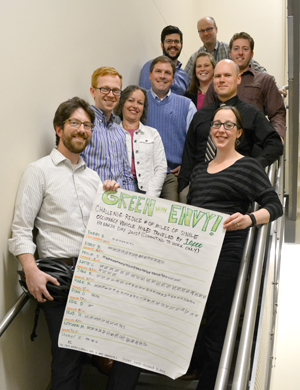
Despite being nine-months pregnant, Kathleen Mayell, Investment Planning director, front right, hasn’t taken the elevator since October, when her third-floor office colleagues took the Green With Envy Challenge. Pictured (counterclockwise from left) are Philip Schaffner, Jake Reuter, Bobbi Retzlaff, Kirby Becker, Erik Baxstrom, Mark Nelson, Katie Caskey, Shaker Rabban and Ryan O’Keefe. Photo by Shannon Fiecke |
- The Environmental Planning and Design Unit, in the Office of Environmental Stewardship, is pursuing an electronic landscape plan and construction efficiency pilot project that could reduce staff time by 70 percent and paper usage by 85 percent.
- Gupthan Namboodiripad, Office of Finance, commuted by transit or walking 85 percent of the time and avoided the use of plastics.
MnDOT’s next Earth Day challenge
Last year, Commissioner Charlie Zelle encouraged employees to take the Green With Envy Challenge. This Earth Day, Chief Engineer Sue Mulvihill encouraged staff to carpool to work meetings and schedule video or teleconferences whenever possible to conserve gasoline. Another option is a state plane, which is often less expensive than driving for long trips. (The Office of Aeronautics has an online fly-drive calculator to help you determine the relative costs of driving versus flying.) |
 |
|

|
 |
TABLE of CONTENTS
 |
MnDOT nears 5 percent efficiency goal as part of Enhancing Financial Effectiveness effort |
By Shannon Fiecke
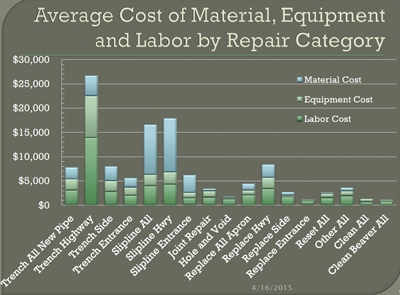
The Asset Management project team is tasked with identifying the lifecycle costs of MnDOT’s pavements, bridges, hydraulic infrastructure, tower lighting and overhead sign structures by December 2015. This chart shows the average costs for different culvert maintenance items and repair work performed by MnDOT teams. |
MnDOT is nearing its goal of identifying $60 million in cost savings across the agency, as employees continue to work on their goals for Enhancing Financial Effectiveness.
The Financial Management battle team is tallying these savings and developing a budget that will show how much the agency spends on each product or service.
“These are things we’ve been talking about doing for two decades,” said Tracy Hatch, deputy commissioner and chief financial officer, who listened to progress reports on April 16.
The four EFE “battles” under way by the project management, asset management, financial management and information and outreach teams will give MnDOT the tools to better measure and control its costs. This is essential as the agency works to document efficiencies equivalent to 5 percent of its annual road construction budget, as directed by the Legislature.
At the quarterly progress meeting, the Financial Management group (see PowerPoint presentation) reported approximately $50.1 million in efficiencies. Another $14 million in possible savings are contingent on the outcome of Early Let/Late Award construction projects.
Progress on many fronts
The other EFE battle teams are also racking up successes as they move toward their year-end deadlines:
- New data from the asset management effort will help MnDOT predict future road maintenance costs and make better choices for when to invest maintenance dollars. For the first time, the agency tied road maintenance cost records with pavement condition data that’s collected annually on each state highway. The team produced pavement data charts that compare the cost per mile of fixing highways with different pavement surface ratings. The data will improve the accuracy of the current pavement management system the agency uses to determine when to apply maintenance treatments, said Douglas Maki, Metro District graduate engineer. It also backs up MnDOT’s policy that it’s more cost-effective to keep good roads in good condition than to invest heavy maintenance dollars in poor roads.
- The Information and Outreach team created the Get Connected website to educate the public about transportation finance, financial effectiveness and how MnDOT makes its decisions, all while answering the questions the public is most interested in (as identified through market research). The group’s next goal is to increase website traffic to 12,000 visitors by the year’s end.
- A more balanced letting schedule is the goal of the Project Management team, which shifted many construction projects out of the FY16, FY17 and FY18 fourth quarters. This should help even out workloads and lead to lower bids since contractors prefer projects in the second and third quarters. Nancy Daubenberger, Engineering Services Division director, said it’s a challenge to only let 10 percent of projects in the fourth quarter, but staffs aren’t complaining because they know why it’s important to reach that target.
“When we talk about big ticket efficiencies, this is where you make it,” said Emma Corrie, Operations Division Business manager.
|
 |
|

|
 |
TABLE of CONTENTS
 |
Toward Zero Deaths targets schools, businesses to reduce traffic-related deaths |
|
By Kristine Hernandez, Minnesota Toward Zero Deaths program coordinator

Mark Griffith, South Central EMS Association executive director, participates with a Lake Crystal Wellcome Memorial High School student attempting to text and drive through an obstacle course as part of a community outreach event at Minnesota State University-Mankato. Students learned about the dangers of texting and driving. Photo by Annette Larson |
Eighteen schools and four businesses competed statewide this month to encourage communities to put the phone down and not to text while driving as part of the It Can Wait campaign created by AT&T.
During the week of April 6-10, high schools, colleges and businesses were urged to take an online pledge never to text and drive and to help spread the word to their families and friends about the dangers of texting and driving. The It Can Wait campaign served as the kickoff to the following week’s statewide distracted driving extra enforcement wave.
The campaign included Toward Zero Deaths Regional Steering committees, TZD Safe Roads coalitions, Network of Employers for Traffic Safety and the Minnesota Safety Council. More than 1,600 pledges were given by those competing to see who could generate the most texts, raising awareness to never text and drive.
This was the fourth It Can Wait campaign aimed at schools in Minnesota.
Participants included the following high schools: Aitkin, Blue Earth, Crosby-Ironton, Hill City, Lake Crystal Wellcome Memorial, Maple River, McGregor, Perham, St. Clair, United South Central and Waterville-Elysian-Morristown; as well as Anoka-Ramsey Community College, Hibbing Community College, Minnesota State University-Mankato and Rochester Community and Technical College.
The friendly competition is just one way to reach an audience that seems unreachable by traditional methods – high school and college-age students. Winners of the no texting while driving competition received a plaque from AT&T.
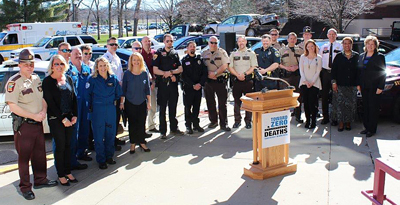
The Southeast Minnesota Toward Zero Deaths partners held a Distracted Driving News Conference & Community Outreach Event April 13 at University Center in Rochester to kick off the enhanced enforcement campaign. The news conference was followed by an event where students and staff heard from the State Patrol, a personal impact speaker and TZD representative regarding the dangers of distracted driving. Students also had an opportunity to use a driving simulator to experience how texting affects their driving. Photo by Scott McConkey |
Text messaging is the main mode of communication for most American teenagers, with half of all teens sending between 21 and 70 texts a day; and 90 percent of them expecting a reply within five minutes. In an AT&T survey, 43 percent of American teenage drivers, ages 15-19, admitted to texting while driving even though 97 percent know it is dangerous.
“These are groups who aren’t overwhelmingly watching the local news or reading newspapers,” said Lisa Kons, Minnesota Safety Council. “The challenge is really, how do we reach them?”
MnDOT District 4 and District 8 engaged in a friendly competition that helped the cause.
Other community outreach events complemented the efforts, as well as several news conferences in Duluth, Mankato, Rochester and Shakopee. |
 |
|

|
 |
TABLE of CONTENTS
 |
Stakeholders share ideas on Statewide Freight System Plan details |
By Laurie Ryan, Office of Freight & Commercial Vehicle Operations

MnDOT Assistant Commissioner Sean Rahn provides legislative updates at Minnesota Freight Advisory Committee’s quarterly meeting March 27. Photo by Laurie Ryan |
The Minnesota Freight Advisory Committee’s quarterly meeting March 27 provided an opportunity to share updates of the Statewide Freight System Plan and solicit input from a variety of freight stakeholders. The committee is a partnership between government and business to share ideas and recommend policy and actions to develop and promote safe, productive and sustainable freight transportation in the state.
MFAC Chairman Bill Goins, a FedEx worldwide account manager, kicked off the event that had record attendance. Bill Gardner, director of the Office of Freight and Commercial Vehicle Operations, provided a general overview and MnDOT news. Representatives from trucking, ports and waterways and freight rail gave industry updates. They, along with MnDOT consultants who provided details of the freight plan, spoke to the nearly 60 attendees whose companies, agencies or jobs revolve heavily around freight transportation.
Highlights of the half-day session included Minnesota Statewide Freight Plan: Examining Preliminary Results, presented by MnDOT Consultant Erika Witzke of Cambridge Systematics, Inc., and Mid-Session Update: Discussion of Transportation at the Legislature, featuring State Representative Frank Hornstein and Sean Rahn, MnDOT assistant commissioner for Policy. Margaret Donahoe of the Minnesota Transportation Alliance discussed transportation funding.
With the increasing role that freight transportation has on the state’s economic development and competitiveness, the meeting also included a presentation on Understanding and Enhancing the Value of Freight Economy in Minnesota, by Lee Munnich of the U of M’s Humphrey School of Public Affairs.
“As the economy improves, all modes of transportation will be required to move goods efficiently, thus establishing facilities for the easy transferring of freight from truck to train or train to truck, well-maintained tracks, and highway systems that connect with trains and/or ships,” Munnich said.
Some of the presentations are available at www.mndot.gov/ofrw/mfac/mfac.html.
The University of Minnesota’s Center for Transportation Studies and MnDOT hosted the meeting.
As part of the Statewide Freight Plan’s development, OFCVO formed four ad-hoc groups to address specific freight transportation issues/needs. One of the focus areas is to determine the future role of MFAC. Nearly 17 years ago, MnDOT led the country as the first DOT to form a Freight Advisory Committee. Currently, many of MFAC’s active members, OFCVO staff and MnDOT district engineers are developing recommendations for elevating freight and MFAC to an even higher level. Doing so will enable MFAC to contribute more in freight transportation efforts to facilitate greater economic success for Minnesota. |
 |
|

|
 |
TABLE of CONTENTS
 |
District 4 employees honored with safety award at Employee Day |
By Jerimiah Moerke, District 4 public affairs coordinator

Jody Martinson, District 4 engineer, and Mike Barnes, Operations Division director, present the Zero Lost Work Days plaque at the District 4 Employee Day in Detroit Lakes. Photo by Reid Baumann |
District 4 celebrated a rare — if not unprecedented — achievement April 16 at its Employee Day.
District employees had no lost work days due to injuries in all of 2014.
The district had an average of 237 employees last year, and those employees worked a total of 463,360 hours.
To recognize a year without lost work days due to injuries, Mike Barnes, Operations Division director, presented a plaque to all district employees.
“This is no small feat,” said Barnes. “This is under extreme conditions in weather, and during construction and maintenance.”
The achievement was reached while District 4 crews maintained more than 3,600 lane miles and constructed approximately $70 million in projects across west central Minnesota.
District 4 safety administrator Kohl Skalin says the effort was only possible through extraordinary efforts by both employees and supervisors.
“The credit for the zero lost days goes to everyone,” said Skalin. “All of our employees and managers work hard to recognize hazards on the job and come up with solutions to get the work done safely and efficiently so we can all go home whole at the end of the day.”
Other events at the District 4 Employee Day included a presentation by Lisa Lynn, Century College, who provided ideas on working effectively across different generations; the DNR Wall of Shame; St. Croix Crossing; weather forecasting and retirement planning.
|
 |
|

|
|

|
 |
TABLE of CONTENTS
 |
Past efforts, new approaches help MnDOT mitigate flood damage |
By Sue Roe
Editor’s note: This is the second article in a two-part series marking the 50th anniversary of the 1965 flooding that devastated Minnesota. This article describes how MnDOT’s past and current efforts have helped to prevent and lessen damage caused by flooding.
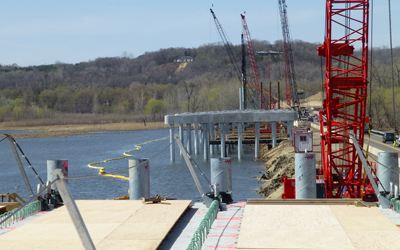
The Hwy 101 project, known as the Southwest Reconnection Project, is under way between Shakopee and Chanhassen. The new bridge will raise the current highway above the 100-year Minnesota River flood plain. The $54 million project is scheduled for completion this fall. Photo by Paul Gronvall |
In April 1965, widespread flooding in Minnesota caused major damage nearly statewide. Even 50 years ago, the then Minnesota Highway Department worked to minimize and prevent future damages.
“In South St. Paul, a dike, which was built for the 1951 flood, was raised about three feet as an emergency measure to keep the 1965 floodwaters out of the stockyards and meatpacking plants,” according to a 1970 report issued by the U.S. Department of Interior. “This dike, which was three and a half miles long, protected many South St. Paul facilities.”
The Wabasha-Nelson Dike, built where the Mississippi and Chippewa rivers meet in southeastern Minnesota, was raised four feet after the 1952 flooding, but it washed away in the 1965 flood.
“There were also many flooded highways in the state affected by the runoff of the 1965 spring melt,” remembers Jack Pirkl, Metro District assistant bridge maintenance engineer. “Some of these roads were rebuilt to higher elevations and the impact of truly high water is minimal today.”
Past flood events shaped the way MnDOT studies, designs and builds infrastructure today.
“In 1965 we did a lot of flood monitoring and took high water measurements during the flood,” said Andrea Hendrickson, state hydraulic engineer. “That information and data is what was used to calibrate models for future projects.”
Following two major flooding events in 2010, the state Legislature authorized funding for a five-year flood mitigation program to improve drainage structures, slopes, berms and ditches, and raise existing roadways.
MnDOT completed a Minnesota River Flood Mitigation study in 2011 to identify ways to improve mobility during seasonal flooding of the Minnesota River in the southwest Twin Cities metro area. The study identified design options at each river crossing studied to minimize flooding risks without increasing the 100-year flood plain elevation.
The Hwy 101 Minnesota River crossing between Shakopee and Chanhassen is one of the flood mitigation projects. Flooding closed the crossing for 15 days in 1965, 27 days in 1993 and 2010, and 43 days in 2011. Work began in 2014 to build a new bridge across the flood plain of the river to raise the roadway out of the 100-year flood elevation. See more about the project at www.mndot.gov/metro/projects/hwy101river/index.html.
“Transportation will be improved because the Hwy 101 project will reduce the frequency and duration of road closures caused by flooding, minimize transportation disruptions, and minimize long-term maintenance and repair costs,” said Nicole Bartelt, assistant waterway engineer.
In District 7, Hwy 169 was closed four of the past five years due to flooding. In 1965, the Minnesota River reached the second-highest level ever recorded at Mankato. The district will raise the highway out of the flood plain from St. Peter to Mankato. See more about the project at www.mndot.gov/d7/projects/floodmitigation/.
This summer, District 4 will realign Hwy 75 near Kent . New bridges will take the roadway above the 100-year flood elevation.
“The flood mitigation program helps District 4 develop a long-term solution to annual flooding in our region,” said Shiloh Wahl, District 4 program development manager. “This program helps prevent maintenance and travel user costs, along with creating a safe sustainable roadway network well into the future.”
See a complete list of current flood mitigation projects at www.mndot.gov/floodmitigation/list.html.
MnDOT provided funding to support the National Oceanic and Atmospheric Administration’s National Weather Service development of Atlas 14 to provide precipitation frequency estimates for Minnesota. Atlas 14 updates previous precipitation frequencies, which can be decades old. The analyses of past heavy rainfall events help engineers and others design and operate infrastructure such as culverts, storm drains and ponds.
“We want to use the best precipitation data available so we don’t undersize our culverts and risk flooding, or oversize our culverts and overspend,” said Hendrickson.
Flooding in 2010 and 2012 highlighted the need for MnDOT to participate in a Climate Resilience Pilot project to look at the effects of climate, and specifically heavy rainfall, on the state’s trunk highway system. The Federal Highway Administration selected Minnesota as one of 19 projects.
The project’s report, Flash Flood Vulnerability and Adaptation Assessment Pilot Project, states that MnDOT traditionally assumed that future conditions will be similar to those of the past, but climate change requires new approaches to understanding vulnerabilities in the transportation system so risks can be minimized.
The project focused on District 1 and District 6, which experienced severe flooding in recent years.
MnDOT conducted a flash flooding vulnerability study in 2013-14 on the entire trunk highway system in each district. The study looked at bridges, culverts, pipes and roads paralleling floodways. One vulnerable facility in each district was selected as a case study on how cost-effective decision-making can be made in the context of a changing climate, said Philip Schaffner, policy planning director in the Office of Transportation System Management.
The project evaluated options for the at-risk facilities in each district and developed a process to identify cost-effective planning and design solutions to increase resiliency.
The evaluation also will support MnDOT’s asset management planning efforts.
Read more on the climate change study at www.mndot.gov/climate/pilotproject.html.
For the first article in the series, see www.newsline.dot.state.mn.us/articles.html#1.
|
 |
|

|
 |
TABLE of CONTENTS
 |
What’s new on the web |

Graphic shows the layout of the new District 2 web page. |
District 2’s web pages have a new look!
You may have noticed minor updates to the way that news, projects and public involvement content is presented on District 2’s web pages. The goals were to sort information by area, to reduce confusion with more streamlined navigation, and to better focus on the content recommended most by viewers.
Check it out – and watch as more district pages are updated in the near future. If you have questions, let Web Team know! Email webteam.dot@state.mn.us.
New Library Materials posted on the web
New Library Materials are available at www.mndot.gov/library/newlibmat.html. This issue features reality-based leadership by New York Times best-selling author Cy Wakeman.
New Library Materials is a compilation of new titles and other resources added to the library collection during the previous month. If you would like to be added to the distribution list, contact pamela.m.gonzalez@state.mn.us or 651-366-3749.
Previous editions of New Library Materials are archived and available at www.dot.state.mn.us/library/recacq-archive.html. For other information requests, contact the Library at 651-366-3791 or e-mail library.dot@state.mn.us, or send requests via the Ask a Librarian web page.
Internet Explorer 11 is on the way.
MnDOT will be transitioning from the current internet browser, Internet Explorer 9, to Internet Explorer 11. The transition must be completed by the end of December when Microsoft will be ending its support for IE9 and all previous versions of Internet Explorer.
Once testing is finished, deployment to individual computers will be completed automatically and will not require a manual installation.
Internet Explorer 11 will provide a faster browsing experience and has better security features.
|
|
 |
|
___________________________________ -->
| |
|



